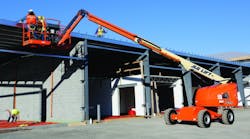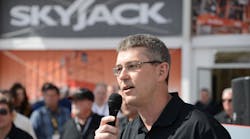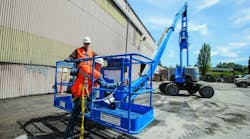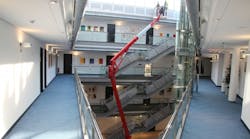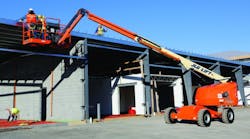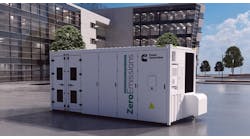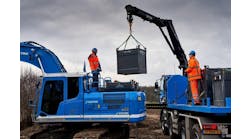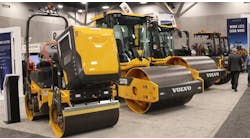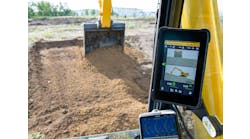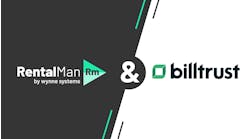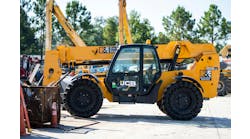Manufacturers are making aerial work platforms safer, smarter, and more efficient. A wide range of manufacturers explain the evolution of aerial.
PARTICIPANTS:
Matt Fearon, Genie president, Terex AWP
Ben Coleman, general manager - product & commercial operations, JCB North America
Malcolm Early, vice president of marketing, Skyjack
Janne Pulkkinen, vice president, Bronto North America
Maxime Girard, product manager for the Americas, Haulotte
Matthew Elvin, CEO, Snorkel
Justin Kissinger, marketing manager, Custom Equipment
Paul Kreutzwiser, global category director – Aerial Work Platforms, JLG Industries
RER: What have been your most recent technological developments on your equipment?
Fearon: Two important developments Genie has been focused on rolling out are related to the changing requirements of our global customers and how end-users do work safely and productively. The first development is the introduction of the new Genie Lift Guard Contact Alarm system, an electronic secondary guarding solution that we offer standard on most Genie boom products. It is an innovative solution that our customers have been asking for, providing another layer of operator protection at the platform controls. The solution is robust and unobtrusive, but its brilliance is in its simplicity.
From a machine standpoint, Genie is heavily invested in continuing to maximize the value and rental return on invested capital (rROIC) of our products. Even as global standards are changing how operators do work, we are looking at ways of increasing their productivity. The new Genie Xtra Capacity (XC) booms are designed to provide exceptional capacity consistently across a wide range of products. When customers see the “XC” nomenclature on a Genie machine, they will know that they are getting 660-lb capacity over the maximum range of motion, and 1,000-lb maximum capacity to tackle even the heaviest jobs in less time. The “XC” stamp also signifies that these machines meet the overload requirements of the new ANSI and CSA standards for North America, as well as the EN280 standards in Europe and the AS 1418.10 standards in Australia.
Coleman: In March 2017, JCB has signaled its intention to become a major player in the $8-billion global aerial work platform market with the launch JCB Access, a range of 27 scissor lifts and articulated and telescopic booms.
Early: That will be those encompassed in the launch of the SJ85 AJ. The SJ85 AJ, we combined an outstanding reach envelope with dual platform capacities of 750/500 pounds (340/227 kg) and two/three personal rating, setting the SJ85 AJ apart and making it the most efficient machine for operators looking to maximize productivity and jobsite performance.
The SJ85 AJ features a class-leading working height of 91 ft (27.73 m), horizontal outreach of 56 ft (17.07 m) and a superior up-and-over clearance of 34 ft (10.36 m).
Pulkkinen: We are introducing our new XR series (184-230ft) which is the most compact series ever in size in our history and has performance values that even exceeds those of competition. Also, we will introduce this fall a new insulated product SI219HDT-C at ICUEE 2017 with voltage rate up to 765kV. This is world’s tallest insulated product and after that we’ll have a comprehensive range of insulated products starting from SI140HDT-C.
Girard: Stop Emission System
Haulotte has recently release the Stop Emission System. The Stop Emission System automatically stops the engine if it has been idle for 90 seconds and restarts the engine by engaging the foot pedal. When operators are working at height, the engine often runs for no reason, resulting in the hourmeter counting hours unnecessarily. The system reduces use of the engine and peripheral components by up to 20%, thereby extending the life of the engine and assuring higher residual value. In addition, by decreasing fuel consumption, operating costs are lowered, and the overall noise level is reduced, allowing operators to work in sensitive areas (hospitals, schools, office buildings, etc.).
Activ’ Lighting System
Haulotte has also introduced the Activ’ Lighting system to the market this year. Loading and unloading the boom on a truck is always a delicate procedure, especially when there is limited visibility, such as at dawn or dusk. To simplify this procedure while enhancing user safety, Haulotte developed an innovative and ultra-high-performance lighting system, ACTIV’Lighting System-Safe Load. Located at several points around the machine, this lighting system illuminates controls and the area around the boom. Only offered by Haulotte, this is a unique feature becoming an essential element for the safety of both men and equipment.
Activ’ Screen
In case of a problem or malfunction, it is always more advantageous to have easy and instant access to the information necessary to intervene or remotely troubleshoot with a technician. Haulotte released the ACTIV’Screen on-board diagnostic system, a comprehensive tool that provides access to: details and the complete malfunction resolution procedure, machine settings, preventative maintenance alerts and service intervals, and modifications of general settings such as interface language and units of measurement. Haulotte ACTIV’Screen acts as a genuine assistant, supporting users daily in carrying out maintenance operations. It gives the operator access to key real-time information on the function and status of the machine.
Elvin: At Snorkel, we have recently introduced and unveiled significant technological advancements across a number of our product lines. At ConExpo 2017, we showed a concept design for an all-electric scissor lift, the Snorkel S3019E. This innovative design has zero hydraulic hoses anywhere on the lift, and has a low step-in height for reduced operator fatigue.
As part of upgrades to our telescopic mast lift family, we introduced the Snorkel TM12E and TM16E at ConExpo 2017. Both of the new lifts include platform load sensing to comply with various national standards, and the TM12E is already in production and available to order.
On our latest line of mid-size telescopic boom lifts, we have introduced proportional throttle, which means that the throttle speed is matched to demand, helping to reduce noise and fuel consumption when only slow speeds are required. We have also introduced engine-mounted generators on this new family of boom lifts, for efficient use of engine power and space.
Kreutzwiser: At CONEXPO, JLG showcased several new technologies designed to make equipment more productive and profitable.
One of these was SmartLoad Technology on its new high capacity telehandlers. SmartLoad Technology is a bundle of three integrated technologies. Included in the bundle is attachment recognition, which allows a telehandler to identify an attachment and display the appropriate load chart to the operator. The second technology, a load management information system (LMIS), graphically depicts a load’s location within the load chart, provides an indication of compliance, and prevents the operator from violating the chart’s boundaries. A load stability indicator (LSI) completes the technologies, working with the LMIS to limit operation when a load becomes non-compliant. Combining attachment recognition with real-time load data gives operators greater confidence during operation and protects fleets by giving operators additional guidance on load capabilities.
A second new technology, the No Touch Enhanced Detection System (EDS), is an advancement of our existing Soft Touch System. Soft Touch uses whisker proximity switches to stop a machine when it makes contact with an object or structure. No Touch uses advanced infrared technology to sense an object or structure is nearby, first slowing, then stopping the machine before it makes contact. A visual and auditory warning alerts the operator when a boom or scissor approaches a structure. No Touch EDS then stops the machine, limiting its operation to reverse mode unless the operator overrides the system to inch closer to complete the work at hand. If the operator doesn’t override the system, the machine remains in reverse mode until it is clear of the obstruction, when it will return to normal operation. No Touch EDS is ideal for aviation, aerospace and other industries where operation near costly structures requires extra care. This technology will be available on select JLG scissors in early 2018 with a phased rollout across the full line of scissors and booms thereafter.
What new technological developments are on the horizon for you?
Coleman: By the end of 2017, the JCB will offer 27 totally new Access platforms, covering more than 80 percent of the aerial work platform rental market. JCB has been developing and engineering this line-up of powered access machines for the past two years.
The line-up will include:
• Nine electric scissor lifts from 15 feet (4.6 m) to 45 feet (13.8 m)
• Three diesel rough-terrain scissor lifts
• Four diesel articulating booms from 50 feet (14.9 m) to 80 feet (24.6 m)
• One electric articulating boom with a working height of 45 feet (13.7 m)
• 10 diesel telescopic booms from 65 feet (20.6 m) to 135 feet (41.1 m)
Early: I would suggest the biggest talking point is ANSI. The American National Standards Institute (ANSI) is expected to update standards for access equipment design standards in late 2017. The A92.20 will replace the A92.5 and A92.6 standards and the term mobile elevating work platforms (MEWPs) will replace aerial work platforms (AWPs). To comply with the new standards, North American manufacturers are getting ready to produce machines that meet the new A92.20 standards. Five major changes are expected to affect the industry:
1. Load-sensing system requirements
2. New wind force rating
3. New stability testing
4. New railing height
5. New platform entries
Skyjack has taken the opportunity to address certain features that could be improved. The thought being that if ANSI means a cost up what can we do to re-balance the Return on Investment equation.
Pulkinnen: We will be updating our product offering on both, smaller and on taller end using mass-customization principles.
Elvin: Following the unveiling of our Snorkel S3019E concept at ConExpo, we plan to expand this range of all-electric scissor lifts, which means that they will have both electric drive and electric steering.
Kissinger: We work closely with our customers to develop ways we can help them be more efficient, productive and safe, from adding long-lasting AGM batteries and electrical drive and steering systems to ensuring high platform capacities. We’re continuing to work closely with contractors to develop new solutions for their challenges and drive scissor lift innovation.
Fearon: As we continue to work with our customers on helping them realize the highest rROIC on their machine purchases, we are finding that maximizing their utilization is key. Providing insights into how a machine is utilized and what may keep it from working are instrumental in planning and operating their businesses. Telematics solutions that include information about how a machine is working, as well as what maintenance may keep it from having to come off a job, are a great way to capture and manage this critical data. We are continuing to work directly with our customers to make sure that they have the access to as much of this information as possible, including a link to our machines via a CAN-based control system, as well as what offerings may make them even more efficient in the future.
In general, what trends do you see coming up in aerial equipment?
Early: Again, the upcoming ANSI changes is the biggest trend in the industry, it’ll affect manufacturers, rental companies and end users.
One year after the new standard is published, manufacturers will stop producing machines to meet ANSI A92.5/A92.6 standard and produce to the new standard Existing machines in service remain approved for use and there is no need to update old machines to the new standard.
Outside of the changes mentioned above the largest issue is one of education. Skyjack aims to help rental companies inform their customers about the changes and the implications. So our white paper on the standard is freely available on our web site and we will supply instore point of sale items that explains the standards and implications
We would encourage rental companies to allocate adequate resources to respond to customer inquiries about the new ANSI standards.
Pulkkinen: We are seeing more demand for taller units. New transmission lines are taller, nacelle heights in the wind industry are becoming taller etc. Some cities are also interested in procuring taller units for windows cleaning and building inspection. Generally speaking the use of aerial working platforms will be increasing.
Girard: Like in other industries, engine regulations are going to be more restrictive in the near future. It has already started with TIER4 Final engine regulation.
We think that the AWP industry is going to focus more and more on alternative power solutions such as Hybrid or full electric machines.
Elvin: With ever increasing noise and emissions regulations, we expect to see a continued increase in demand for electric-driven lifts that comply with these requirements and avoid the complexities associated with diesel engines.
In response to the requirement for increased productivity from within our customer base, we are continuing to see demand for higher capacity lifts. As demonstrated by our latest line of mid-size telescopic boom lifts, we are already designing our new lines with higher than industry standard capacities. The new Snorkel 660SJ, for example, has an unrestricted lift capacity of 600 lbs. We anticipate that this trend will continue, and as such we are giving greater focus within our research and development process as to how we increase capacity without increasing dimensions and/or weight.
Kissinger: Safety continues to play a big role in the construction industry, especially when it comes to ladder and scaffold usage. This is why we continue to see growth in the low level access lift market. Every contractor has tools and supplies he or she must handle when working, whether it’s at 2 feet or 20 feet. While ladders allow contractors to reach those higher projects, it puts them at risk for serious injuries from falls. Even scaffolds come with a high risk of falls. They offer a platform from which to work, but workers still must climb up and down the system with tools and materials in tow, which isn’t necessarily safe or ergonomic. Electric scissor lifts, on the other hand, provide a secure space for contractors to move up and down with their equipment and materials to safely complete the job without strain. Falls are one of the biggest OSHA citations, and electric scissor lifts are countering that statistic. It is something contractors are really looking for, not only for safety, but efficiency, too.
Kreutzwiser: Safety must always be at the forefront of machine design and operation. JLG always considers the latest safety trends and regulatory environment when developing new products or product enhancements. Changes to the American National Standards Institute (ANSI) standards which govern Aerial Work Platform (AWP) regulations are anticipated to be published in the coming months. These will drive a number of safety and training enhancements to AWPs or Mobile Elevating Work Platforms (MEWPs) as they are expected to be called under the new standard including: load sensing for actively monitoring loads, stopping a machine’s normal functionality and sounding an alarm when overloaded; hand-operated controls on the platform must also be protected against sustained involuntary operation, preventing further movement of the machine in the direction of trapping or allowing the operator to reverse or stop the trapping movement; more stringent wind force requirements resulting in outdoor machines with increased weight and reduced capacities; new stability testing requirements, with foam filled or solid tires becoming necessary on most booms and rough terrain scissors; and an increase to scissor rail heights, necessitating fold-down rails on compact models to ensure they fit through standard height doorways.
The ANSI changes will move MEWPs more towards global standardization. While the standards will result in several changes to existing product lines, manufacturers such as JLG already offer a range of access equipment that is compliant with many of the anticipated changes.
Compact crawler booms are gaining increased use in utility and facility maintenance applications due to their ease of portability, compact size and ability to be used indoors or outdoors with minimal impact to sensitive flooring or grounds.
JLG EcoLift and LiftPod low-level access products continue to gain momentum in replacing scaffolding and ladders in industrial and facility maintenance applications These products reduce set-up time for improved productivity and provide a safer solution for working at height to deliver strong value.
We are also seeing continued interest in Hybrid models due to their environmentally friendly and energy-efficient operation. We anticipate increased interest in Hybrid and energy efficient access equipment moving forward.
Fearon: There are a few trends that we are seeing that are related to some of the development work we have been doing over the last few years. As emissions standards around the world have become more stringent, engine manufactures are forced to provide solutions that are more costly and complex. To mitigate this, Genie has developed an innovative fuel-electric system for the Genie Z-60/37 FE articulated boom that gives performance of a typical diesel-powered boom in a hybrid machine.
Another trend in our industry is the focus on secondary guarding for the operator. We have developed multiple solutions that have been well received by our customers and end-users. The Genie Operator Protective Structure (OPS) is a “mechanical” secondary guarding solution that creates a protective zone around the operator at the boom controls, while this option is incredibly effective it can sometimes interfere with the work that is being done. The new Genie Lift Guard Contact Alarm system is our “electronic” secondary guarding solution. It is a simple and effective solution that provides an added layer to operator protection by immediately cutting boom functions and alerting with lights and horn once activated. Unlike many other solutions available in the market, the Genie Lift Guard Contact Alarm system was designed to provide a “free movement zone” around the operator where, even if the operator has triggered the system by being forced into the trip sensor, they have space to move and recover themselves out of harm’s way.
Chapman: Global demand for aerial work platforms is growing rapidly, up from $3 billion to $8 billion over the past eight years, and the market offers immense growth opportunities for JCB. Globally we will continue to see the market comprise of primarily of rental industry customers being served by a limited number of OEMs. The market demands a new supplier with JCB’s ability to offer a whole new standard in build quality, to set new industry norms for machine availability and low cost of ownership. With JCB’s 70-plus years of experience in construction equipment engineering and manufacturing, we believe that we are well positioned to meet the demands of the burgeoning rental industry, and meet its needs for aerial work platforms that are built to a higher standard.
How will the next version of the ANSI standards change things in the aerial equipment market? What changes are you making in manufacturing to conform to those incoming standards?
Girard: The new ANSI Standards will bring several changes but the two most impactful are the following:
- The wind force which will have to be taken into consideration in the stability calculation and tests. This will require heavier machines to be stable enough to work outside. Generally speaking, rental companies will have to clearly identify which machines are able to work both inside and outside or inside only. It means that if their customers, the users, have to work outside, they must have outside rated machines in their fleet, especially for slab electric scissor lifts.
As an example in Europe, where you can find inside only and inside/outside rated scissor lifts, some rental companies ask for indoor/outdoor machines, to be sure that they are offering the safest machines.
Load sensing: the machine will detect overload, resulting in movement’s cut-off and alarm. We expect that if the users are not trained well-enough, rental companies will have to deal with more service calls in order to educate their customers, especially because of the load sensing system that may cause some misunderstanding at least during the first months after the regulation’s effective date.
The new ANSI standard is going to be really close to the European (EN280) regulation. Haulotte, as a French based company, has been doing this since the beginning. This is not a big change for us as bringing more safety to our customers is part of our DNA. Essentially, we are going to sell equipment in North America that has been sold everywhere else in the world for more than 30 years.
Elvin: Aside from the obvious changes in platform load sensing, the new standard will allow us to begin manufacturing a more homogenized machine so that one unit can be shipped globally.
The new handrail height requirement of 43 in. (1.1m) will affect a lot of 19 ft. scissor lifts, as fixed rails won’t be achievable on many existing models. The new line of Snorkel all electric scissor lifts will accommodate this new requirement because of the low entrance height.
All of our new products being released this year already including platform load sensing, and many or all of the other features required for A92.20 compliance to help our customers transition to the new standard.
Fearon: The three biggest changes for the North American aerial market with the new standards coming on line will be the inclusion of “load weighing” or “load sense” systems, the requirements to consider wind forces on machines and the function restriction at chassis tilt limits. These concepts, while familiar globally in areas like Europe, Asia and Australia, will in many cases change how our end-users will need to plan and complete their work. When looking at many of the applications our products are used in, things like platform capacity, indoor versus outdoor operation or the terrain of a jobsite can easily be glossed over when planning work. With the requirements to begin limiting functionality based on the machines specifications, we are aiming at mitigating much of these impacts by making machines even more capable in these otherwise restrictive conditions.
Early: To return to ANSI it brings some changes to testing and operation, and not everyone likes change….BUT ultimately the changes are designed with safety in mind and while it may be tempting to lay the woes of the industry at ANSI’s feet sometimes it is helpful to think about how it increases safe operation of access equipment.
Pulkkinen: Our product strategy has always been to be proactive with expected standard changes. One of the major changes in a new ANSI standard is platform load sensing which has been our practice as far as I can remember. Training has also been an important process for us and for example we have selectable different operator levels based on operator training and skill levels. Training and operator material can be shared easily with help of our web portal Skyliftfleet. Skyliftfleet also has platform data as well as service log in it.
What new safety developments and safeguards have you made on your equipment?
Fearon: The new Genie Lift Guard Contact Alarm system is a great response to the industries demand for simple, effective and unobtrusive solutions to operator protection. It is now standard on most Genie boom models available. Introduced in early 2017, it has been extremely well received by our customers and end-users globally.
Kreutzwiser: JLG announced effective calendar year Q1 2017, that its SkyGuard enhanced control panel protection system is standard equipment across the entire JLG portfolio of boom lifts. When activated, the revolutionary SkyGuard system stops all functions in use at the time, then temporarily reverses most functions that were in use when the system was activated.
SkyGuard can be activated from a variety of angles and provides additional protection without impeding or reducing the work envelope of the boom lift. In also does not increase the boom lift platform profile or limit the use of the platform. The system resets with a cycling foot switch or e-stop. SkyGuard kits are available to customers for specific models of boom lifts ordered prior to 2017.
Kissinger: One of the latest features we’ve worked closely with a customer to develop is a pipe rack that helps workers safely transport materials from the ground to the ceiling for installation. We designed the rack to give the contractor an easy and efficient way to haul more materials to elevated workspaces, and now offer this solution to help other HVAC and plumbing contractors be more productive.
In addition to the pipe rack development we’ve also started to include a tool tray on all of our self-propelled lifts. The tray enhances ergonomics. Users can easily reach tools rather than bend down to pick up materials from the scissor lift deck. We’ve also included a USB port that’s built into the upper control so users can charge electronic devices, such as phones and tablets, on the go. This combination of features helps worker productivity and enhances communication.
Girard: Activ’ Shield Bar: Operators at heights face a number of dangers, particularly crushing risks. To prevent these risks and protect operators, Haulotte has developed the ACTIV’Shield Bar 2.0 (standard or optional depending on models). This secondary guarding system is now fully integrated into the upper control protection cover to guarantee better ergonomics and enhanced robustness. Thanks to the push-forward principle bar, which provides a “safety gap”, workers are protected from any risk of crushing without compromising productivity.
The Activ’shield Bar, Stop Emission system, and Activ’Lighting system are now part of the new Haulotte standards. They will be standard on all our new booms and future releases. Our goal is to continually improve the level of safety on our machines while offering new technologies and solutions to make them greener and more cost effective (TCO).
Coleman: All JCB Access electric scissor platforms feature 4-6 harness points. With fold-down rails and roller operated extension decks, many of the electric scissor models can fit easily through a standard doorway. Maneuverability is enhanced by the unique platform controller, which can be used from any side of the machine, at ground level or at elevation.
From an engineering standpoint, JCB Access machines are built to a higher standard. Full pivot bosses create an increased surface bearing area on the pivot pins. External limit switches are protected by full metal covers, and heavy-duty steel plate protection is featured throughout. Even the step treads and platform access gate benefit from JCB’s decades of experience in construction equipment manufacturing, with both featuring robust construction and ergonomic design for maximum safety.
JCB’s LiveLink telematic system will be incorporated as standard on all JCB Access booms, and it will be available as an option on the Access scissors, providing customers and rental fleets in particular, with a full telematics link for increased security and maximum uptime.
Elvin: Snorkel was the first manufacturer to include a form of secondary guarding as standard on all new-build boom lifts, as well as offer a retrofit option for most existing models in the field. Snorkel Guard has been well received by our customers globally, who appreciate the simple design which does not include any electronics, reducing unnecessary call-out’s and maintenance work.
Any new developments in training?
Pulkkinen: Development steps between the interface of a product and an end user are the most important one when thinking of one’s capability to use the product. With that said, we are in a process of introducing our new 5th generation Bronto+ control system. It has some nice features that assist end user even more efficiently than the earlier versions. Also, it allows more a reliable way for remote access which in turn reduces possible down time.
Fearon: From a training and safety perspective, one of the biggest challenges the industry sees right now is increasing awareness about why safety training is so important. Many companies don't understand their responsibilities, under ANSI/CSA standards, which includes training requirements for aerials — and, not just that they're required by law and enforced by OSHA, but there are very good reasons for the training to keep their operators’ safe. When companies don't invest the time or money to train their people, they chose to take a chance and hope nothing happens. Ensuring that operators, and personnel, are properly trained is one of the first steps in helping to prevent accidents.
To counteract this trend, Genie has made it a company mission to not only raise awareness for training, but we are also committed to helping train the industry. We continue to offer Train the Trainer and our Genie Lift Pro™ Online Training Courses, a high-quality, professional-grade program delivered through a web-based platform. The Genie Lift Pro Online Operator Training Courses satisfy the general training requirements as defined by OSHA, ANSI, ITSDF and CSA.
Coleman: JCB’s global dealer network has been undergoing full sales and service training to be able to provide world-class back-up for the access platform ranges.
Kreutzwiser: Access Ready:
In 2017, JLG introduced AccessReady (https://accessready.jlg.com), which connects operator trainees to JLG-qualified professional trainers, making it easier to find JLG and competitive brand AWP and telehandler training in their area.
JLG-qualified professional trainers provide operator training to the customers or employees of independent rental centers, equipment dealers or directly to a company who owns a fleet of access equipment. AccessReady also offers operator trainees the option to complete an e-learning course or courses. They then find an area-based JLG-qualified instructor through the AccessReady portal to complete the hands-on evaluation necessary to gain operator qualification.
Operators who successfully complete the training are qualified for three years for telehandlers and indefinitely for AWPs.
Lift and Access Equipment Simulator:
The JLG equipment simulator employs advanced virtual reality technology to familiarize operators with the controls and operation techniques of boom lifts. A multi-player version of the virtual reality simulator enables two operators to interact with each other in real-time, while experiencing true-to-life job site scenarios as they maneuver equipment on mixed terrain, completing specific tasks in the same virtual environment.
JLG has long been focused on providing industry-leading field-based or classroom-style product and service training courses at our dedicated Training Center and Proving Grounds in McConnellsburg, Pennsylvania. Our virtual 3D equipment-training simulator is a next level development for our training program.
Virtual experiences – such as those offered by the JLG equipment simulator – engage users, transforming them from passive audience members in a classroom setting to active participants in the training process. It trains them to operate JLG access equipment through a hands-on, life-like experience, allowing them to become familiar with equipment controls, master operational skills, and hone their ability to make decisions while on the job.
The JLG virtual training simulator was demoed earlier this year at ConExpo and will be available to customers for purchase in the near future.
Early: OK it’s back to ANSI !! We are focusing on training and educating our employees and customers about the upcoming ANSI changes. As I mentioned above, there will be five key changes that will affect the industry, and when it comes to training itself, the new ANSI standard is expected to provide flexibility. The A92.20 standard allows qualified operators to self-familiarize and recognizes online theory training for operators. Plus, unlike the current manual of responsibilities, which is divided into multiple machine-specific versions, the new ANSI standard has one single document that covers the responsibilities for all MEWPs.
Girard: Haulotte offers various product training throughout the year. Customers can view a calendar of our current training schedule online and register by emailing our trainer. More information is found at this link: http://www.haulotte-usa.com/service/training
Kissinger: Safety is the number one priority on every jobsite and we’re always looking for ways we can enhance that, both through the designs of our low-level scissor lifts and through industry associations, such as the Occupational Safety and Health Administration.
In general, what are your expectations for the aerial market in the foreseeable future, in North America and internationally?
Pulkkinen: North America is a tough market to crack. But for as long as general safety consciousness continues to become more and more important we should be able to get market share from more conventional ways of lifting people up high. The more companies see safety and efficiency gained by working with truck mounts the more growth. Internationally market areas all over the world are in different stages. It is our advantage to see global view and utilize lessons learned from different markets.
Fearon: As our customers continue to become more technological savvy, we are seeing growing trend in the use of technology for fleet management. Telematics is a tool that many are starting to use to manage their equipment fleets, from basic location tracking to more sophisticated equipment monitoring. From knowing how equipment is performing or how often a piece is being utilized to where each unit is or when it is ready for maintenance, machine data can provide a lot of insight to a rental business. T Today’s technology can help our customers gather, read and understand the information their machines are providing. In my opinion, we are in the early stages of the adoption of telematics, mobile applications and data-driven fleet management. I expect rental companies around the world to increase their use of these capabilities in the coming years to drive higher rROIC.
Elvin: Our customers in North America, and around the world, are optimistic. We are expecting trading conditions to remain positive, and this is backed by the recent reports from the American Rental Association who just this week released their latest quarterly update which suggest that we will see steady gains in the rental sector through 2021. Internationally, IPAF recently released their rental market report, which suggests that Europe has entered a phase of steady growth for the second year running, which is expected to continue in the coming years. These are all very good signs for our industry, with the majority of aerial lifts being sold into the rental sector.
Coleman: Globally, JCB assesses the demand for aerial work platforms to be near 143,000 units a year, valued at approximately $8 billion annually, significantly up from $3 billion in 2009. This market demands a new supplier with JCB’s ability to offer a whole new standard in build quality, and industry-leading product support. JCB’s global network of 770 dealers, with 2,200 locations, can deliver the back-up that global customers expect.
Kissinger: I believe we will continue to see safety play a bigger and bigger role, particularly when it comes to ladder and scaffold usage. The new ANSI/CSA changes will make standards more similar across the board as well. In turn this will likely boost aerial lift sales. One of the biggest challenges we see is the difficulty contractors have in justifying the need and price of scissor lifts, whether they are renting or buying. Ladders are inexpensive and easily accessible; most contractors have plenty on hand they can grab and go. But contractors must also consider the costs associated with just one worker’s compensation claim. The risk of falls from ladders and scaffolding is high and so are the costs associated with a claim, which averages $98,000 in medical care and lost wages per person. Safety is one of the hallmarks of our business and we will continue to educate the market on the risks associated with ladders and scaffolding as well as how our Hy-Brid Lifts offer an alternative that’s not only safer but also more efficient and productive.
Early: At the time of writing the major North America companies have released positive results and just as importantly their view on the future is positive. Europe is undergoing growth at the minute as well. In summary I would offer a positive view over the next year or so, remembering that even if there is a flattening it’s at a generally high level.
Girard: We expect a slight decrease of the worldwide market in the next few years, driven by North America. But globally the market will remain at a high level.
